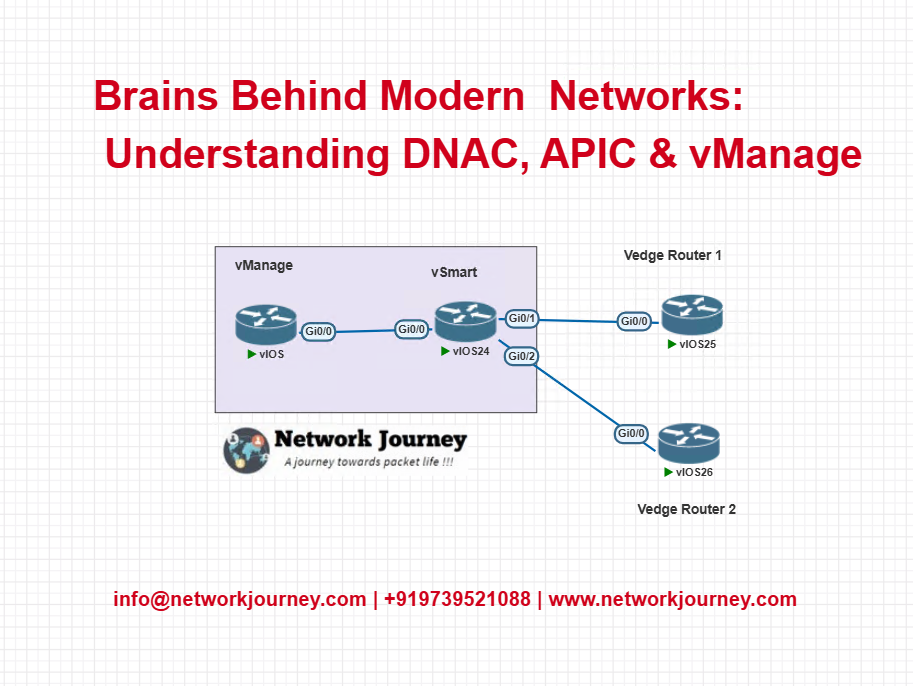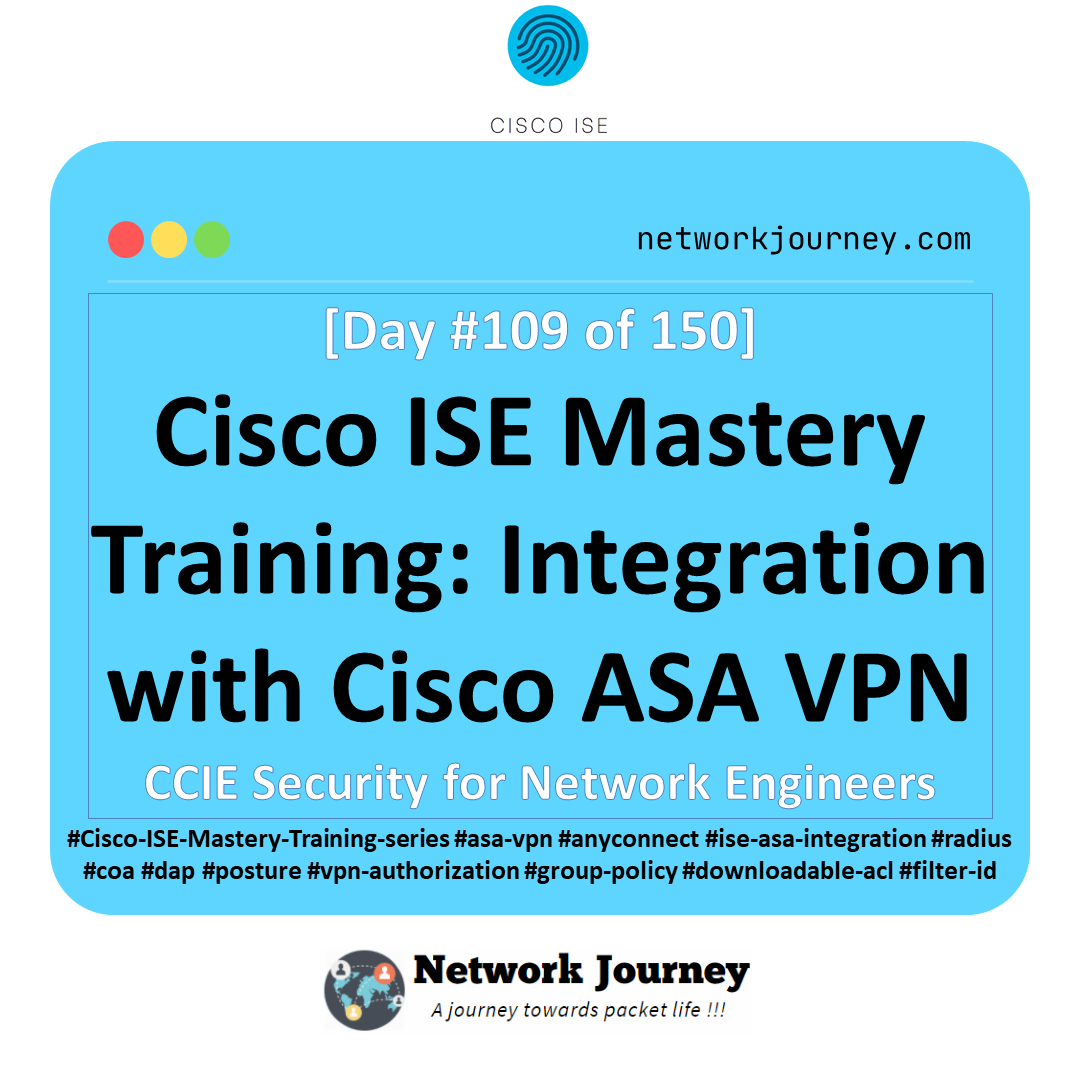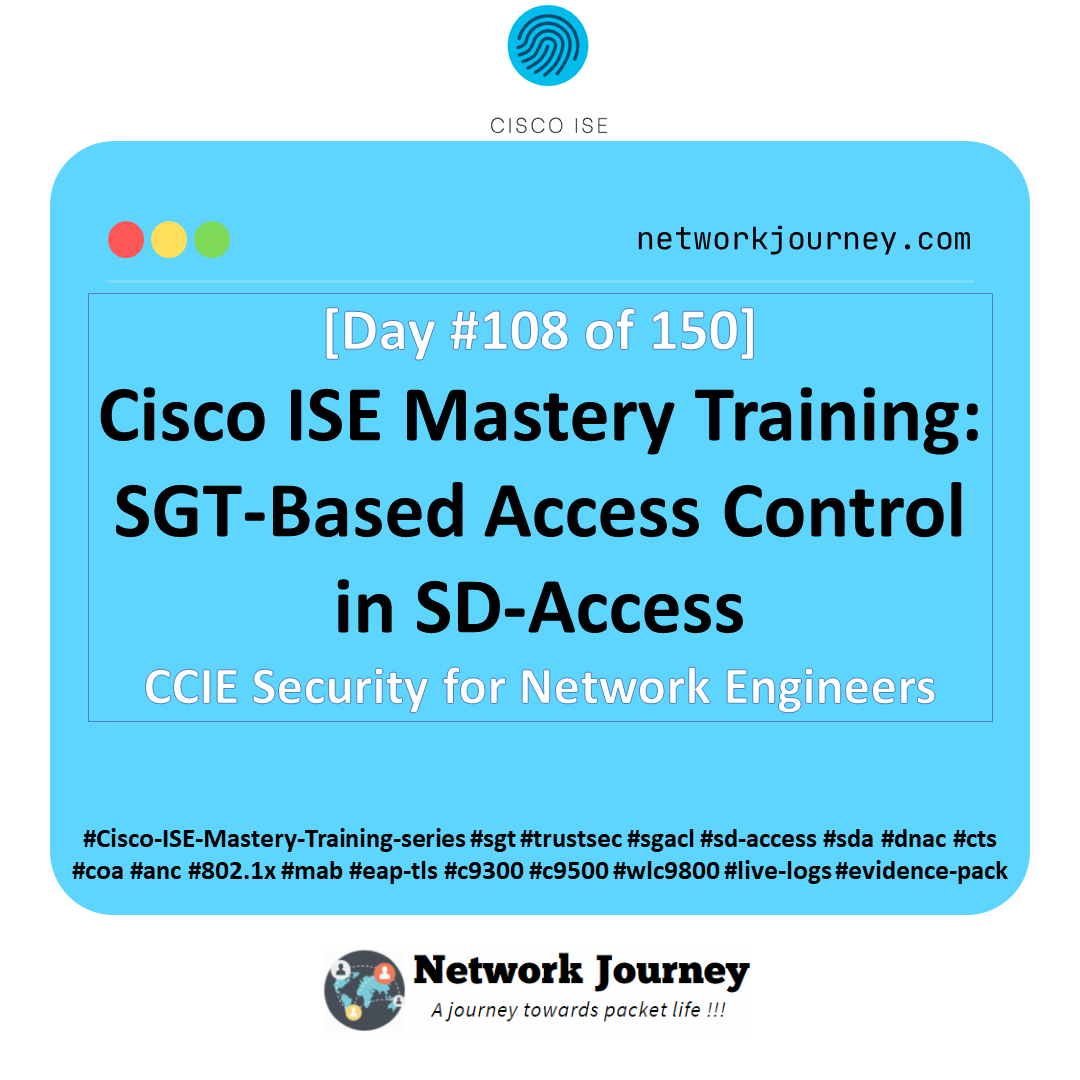Brains Behind Modern Networks: Understanding DNAC, APIC & vManage [CCNP Enterprise]
If you’ve ever wondered what’s powering the magic behind modern, intelligent, and self-healing networks — you’re in the right place. Today’s enterprise networks aren’t managed switch-by-switch anymore. We have smart controllers that do the heavy lifting, automate configurations, and even apply intent-based networking.
In this blog, we’ll simplify three powerful technologies: Cisco DNA Center (DNAC), Cisco APIC (used in ACI), and Cisco vManage (used in SD-WAN). These are the brains behind Cisco’s modern network solutions. Whether you’re a CCNP Enterprise student, network admin, or just curious — I’ll walk you through concepts, comparisons, real labs, and more.
Let’s unlock the intelligence behind your network!
Table of Contents
Theory in Brief – What Are DNAC, APIC, and vManage?
Cisco has moved from traditional CLI-based device-by-device management to controller-based architectures. These controllers centralize and simplify operations by giving you a GUI, APIs, and automation at scale.
Cisco DNA Center (DNAC)
- Platform: Used in enterprise campus and branch networks
- Main Role: Network automation, assurance, and analytics
- Key Features: Plug-and-play, Software-Defined Access (SDA), policy enforcement, telemetry
- Use Case: Automating large LAN/WLANs in offices and campuses
Cisco APIC (Application Policy Infrastructure Controller)
- Platform: Core controller for Cisco ACI (Application Centric Infrastructure)
- Main Role: Manages fabric switches and policies in data centers
- Key Features: Leaf-spine automation, application-centric policies, multi-tenancy
- Use Case: Large-scale data centers with private cloud or hybrid setups
Cisco vManage
- Platform: Core controller for Cisco SD-WAN
- Main Role: Centralized orchestration, management, and policy distribution
- Key Features: Overlay control, real-time app monitoring, transport independence
- Use Case: WAN automation, branch connectivity, cloud-first networking
DNAC vs APIC vs vManage – Comparison
| Feature | Cisco DNAC | Cisco APIC | Cisco vManage |
|---|---|---|---|
| Main Use Case | Campus LAN/WLAN Automation | Data Center Fabric Controller | SD-WAN Overlay Management |
| Physical or Virtual | Appliance (or Virtual) | Physical or Virtual | Virtual (on-prem or cloud) |
| Network Type | SDA (Software-Defined Access) | ACI (Leaf-Spine Architecture) | SD-WAN |
| Policy Management | Yes | Yes | Yes |
| Telemetry & Analytics | Yes (AI/ML insights) | Yes | Yes (App-aware routing) |
| REST APIs | Yes | Yes | Yes |
| CLI Dependency | Reduced | Reduced | Reduced |
| Typical Users | Enterprises, Campus IT | Data Center Admins | WAN Admins, MSPs |
Pros and Cons
| Controller | Pros | Cons |
|---|---|---|
| DNAC | AI-driven assurance, easy onboarding, SDA support | Requires DNA licensing, steep initial learning curve |
| APIC | End-to-end automation in data centers, app-centric | Complex policies, requires ACI hardware |
| vManage | Centralized WAN config, cloud-ready, scalable | Requires vBond/vSmart coordination, learning curve in policies |
Essential CLI Commands
While controllers are mostly GUI/API-driven, these CLI commands help verify or troubleshoot underlying issues.
| Purpose | Command | Use Case |
|---|---|---|
| Show vManage status | show sdwan control connections | Check SD-WAN control connections |
| Show APIC health | acidiag fnvread | APIC hardware/fabric status |
| DNA Center device discovery | `show run | include cdp` |
| SD-WAN tunnel status | show sdwan tunnel | Verify SD-WAN tunnels |
| APIC leaf connectivity | show fabric topology (in GUI/CLI) | Verify spine-leaf connectivity |
| SDA edge node status | show fabric edge-node | Check DNA fabric nodes |
Real-World Use Cases
| Scenario | Controller Used | Description |
|---|---|---|
| Automating VLANs and wireless access in a campus | DNAC | Uses Plug and Play + policy groups for onboarding and segmentation |
| Deploying multi-tenant data center for cloud hosting | APIC | Automates tenants, contracts, and fabric forwarding |
| Connecting 300 branch offices via broadband/MPLS mix | vManage | Uses control policies, TLOCs, and app-routing to optimize WAN traffic |
| Troubleshooting high latency in application delivery | DNAC & vManage | DNAC shows wired analytics, vManage traces app paths and loss |
EVE-NG LAB – Simulating vManage or APIC
Note: Due to hardware requirements, you can simulate basic vManage setups on EVE-NG more easily than DNAC or APIC.
LAB – Cisco vManage (Basic Setup)
Lab Topology:

Steps:
- Import vManage, vSmart, vEdge OVA files into EVE-NG
- Connect them as shown
- Configure organization name, site ID, system IP
- Use CLI to bring up control connections
- Apply simple policy to route between edges
CLI Sample for vEdge
system host-name vEdge1 system-ip 1.1.1.1 site-id 100 organization-name NetworkJourney ! vpn 0 interface ge0/0 ip address 10.0.0.1/24 no shutdown ! vpn 512 interface eth0 ip dhcp-client !
Check connectivity:
show sdwan control connections
Troubleshooting Tips
| Issue | Controller | Cause | Resolution |
|---|---|---|---|
| Device not discovered in DNAC | DNAC | CDP/LLDP not enabled | Enable CDP on all access switches |
| vManage not connecting to vEdge | vManage | System IP or Org Name mismatch | Double-check configuration and certificates |
| APIC not pushing policies | APIC | Faulty tenant/contract config | Use GUI to trace tenant policy contracts |
| Tunnel flapping in SD-WAN | vManage | TLOCs not balanced | Verify transport color config and control policy |
| Authentication errors on onboarding | DNAC/APIC | Device credentials wrong | Update credential sets in DNAC or APIC |
Frequently Asked Questions (FAQs)
1. What is Cisco DNAC and what role does it play in enterprise networks?
Answer:
Cisco DNA Center (DNAC) is a centralized network controller and management dashboard designed to simplify the automation and assurance of enterprise networks. It enables:
- Zero-touch provisioning
- Policy-based automation
- AI-driven analytics
- Software-defined access (SD-Access)
DNAC serves as the brain of modern campus networks, managing both wired and wireless infrastructure efficiently.
2. How does Cisco APIC differ from DNAC in terms of functionality and deployment?
Answer:
Cisco APIC (Application Policy Infrastructure Controller) is the controller for Cisco ACI (Application Centric Infrastructure)—primarily used in data center environments.
Key differences:
- DNAC = Campus/Enterprise networks (SD-Access)
- APIC = Data Center networks (SDN with ACI fabric)
APIC focuses on application-driven policy management, while DNAC emphasizes device automation and user-centric policies.
3. What is Cisco vManage and how is it used in SD-WAN deployments?
Answer:
Cisco vManage is the centralized network management tool for Cisco SD-WAN solutions. It allows:
- Provisioning, configuration, and monitoring of all SD-WAN devices
- Secure overlay network orchestration across WANs
- Integration with cloud services and third-party security tools
It’s essential for ensuring policy consistency, application-aware routing, and cloud optimization across a distributed enterprise WAN.
4. Can DNAC, APIC, and vManage coexist in the same enterprise network?
Answer:
Yes. Many modern enterprises use all three simultaneously:
- DNAC manages the campus and branch access layer
- APIC orchestrates data center networking policies
- vManage controls SD-WAN overlays and WAN edge connectivity
Together, they offer an end-to-end intent-based networking fabric across LAN, WAN, and DC.
5. Are these controllers hardware or software-based?
Answer:
All three controllers can be deployed as:
- Virtual appliances (on ESXi, KVM, etc.)
- Dedicated hardware appliances
- Cloud-hosted solutions (especially vManage)
Their flexibility allows organizations to deploy based on scale, redundancy, and cloud-readiness.
6. How do these tools support network automation?
Answer:
They enable intent-based networking by abstracting CLI complexity:
- DNAC automates device provisioning and user policy enforcement using templates.
- APIC automates fabric configurations and application connectivity policies.
- vManage automates WAN routing, failover, and VPN segmentation.
Each controller supports REST APIs, Ansible modules, and SDKs for integration with DevOps pipelines.
7. What kind of analytics and telemetry data do they provide?
Answer:
- DNAC uses AI/ML to offer real-time health scores, client insights, and issue predictions.
- APIC provides fabric-wide visibility, endpoint tracking, and flow telemetry.
- vManage displays application-level performance, WAN link quality, and QoS statistics.
These insights help in proactive troubleshooting and performance optimization.
8. What are the licensing requirements for DNAC, APIC, and vManage?
Answer:
- DNAC: Requires Cisco DNA licenses (Essentials, Advantage, Premier), and either physical or virtual DNAC appliance.
- APIC: Comes with Cisco ACI switches (N9K) and requires ACI licenses.
- vManage: Part of SD-WAN licensing tiers (Base, Security, Cloud, etc.).
Each has subscription-based licensing models with differing features per tier.
9. Can these controllers integrate with external systems like ServiceNow, Splunk, or SIEM tools?
Answer:
Yes. All three support northbound REST APIs for integration with:
- ITSM platforms like ServiceNow
- Monitoring tools like Splunk, SolarWinds
- Security solutions like Firepower, Umbrella, or SIEMs
This enhances automation, event correlation, and security posture across the network.
10. Which controller should I prioritize for learning in CCNP Enterprise?
Answer:
It depends on your specialization:
- For enterprise infrastructure (ENCOR/ENARSI) focus → DNAC and vManage
- For data center track → APIC and ACI fabric
That said, vManage is critical in today’s hybrid environments, followed closely by DNAC due to its campus-wide relevance.
YouTube Link
Watch the Complete CCNP Enterprise: Brains Behind Modern Networks: Understanding DNAC, APIC & vManage Lab Demo & Explanation on our channel:
Final Note
Understanding how to differentiate and implement Brains Behind Modern Networks: Understanding DNAC, APIC & vManage. is critical for anyone pursuing CCNP Enterprise (ENCOR) certification or working in enterprise network roles. Use this guide in your practice labs, real-world projects, and interviews to show a solid grasp of architectural planning and CLI-level configuration skills.
If you found this article helpful and want to take your skills to the next level, I invite you to join my Instructor-Led Weekend Batch for:
CCNP Enterprise to CCIE Enterprise – Covering ENCOR, ENARSI, SD-WAN, and more!
Get hands-on labs, real-world projects, and industry-grade training that strengthens your Routing & Switching foundations while preparing you for advanced certifications and job roles.
Email: info@networkjourney.com
WhatsApp / Call: +91 97395 21088
Upskill now and future-proof your networking career!
![Brains Behind Modern Networks: Understanding DNAC, APIC & vManage. [CCNP Enterprise]](https://networkjourney.com/wp-content/uploads/2025/06/Brains-Behind-Modern-Networks-Understanding-DNAC-APIC_-vManage_networkjourney.png)


![[DAY#9 PyATS Series] Parsing show ip interface brief across vendors using pyATS [Python for Network Engineer]](https://networkjourney.com/wp-content/uploads/2025/07/DAY9-PyATS-Series-Parsing-show-ip-interface-brief-across-vendors-using-pyATS-Python-for-Network-Engineer.png)